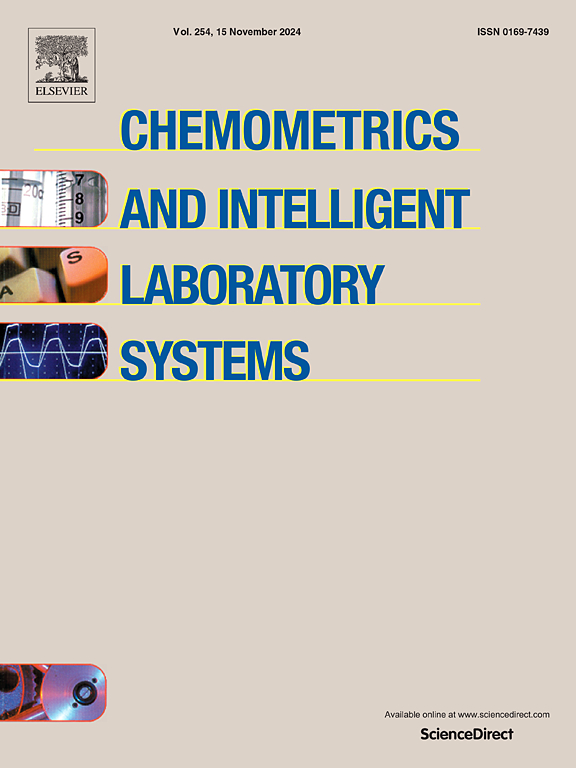利用基于Ve度的可还原拓扑指数对非甾体抗炎药(NSAIDs)的理化性质进行定量结构特性关系(QSPR)分析
IF 3.7
2区 化学
Q2 AUTOMATION & CONTROL SYSTEMS
Chemometrics and Intelligent Laboratory Systems
Pub Date : 2024-11-02
DOI:10.1016/j.chemolab.2024.105266
引用次数: 0
摘要
非甾体抗炎药(NSAIDs)是一类用于不同治疗用途的药物。它们能有效缓解疼痛、减轻炎症和控制发烧。这类药物有多种剂型。医护人员会开非甾体抗炎药来治疗各种症状,从头痛和牙痛到关节炎和肌肉僵硬等疾病。在这项工作中,我们在定量结构-性质关系(QSPR)分析中使用了基于ve-degree的可还原拓扑描述符来估计非甾体抗炎药的理化性质。首先,我们开发了基于 MAPLE 的代码来计算非甾体抗炎药的可还原ve度拓扑描述符。然后,使用线性回归模型估计了 70 种非甾体抗炎药的四种理化性质。结果表明,分子量和复杂性这两种理化性质与基于还原ve-degree的拓扑描述符有很强的相关性。在这两种情况下,相关系数都大于 0.9。最后,构建了二次回归模型和三次回归模型,并对这些模型进行了比较分析。这些结果可能有助于加深对非甾体抗炎药药物结构的理解,并有助于预测其药理活性。本文章由计算机程序翻译,如有差异,请以英文原文为准。
Quantitative structure properties relationship (QSPR) analysis for physicochemical properties of nonsteroidal anti-inflammatory drugs (NSAIDs) usingVe degree-based reducible topological indices
Nonsteroidal Anti-Inflammatory Drugs (NSAIDs) are a class of medications that are used for different therapeutic uses. They effectively alleviate pain, reduce inflammation, and manage fever. These drugs are available in various forms. NSAIDs are prescribed by healthcare professionals to address a wide range of symptoms, from headaches and dental pain to conditions like arthritis and muscle stiffness. In this work, we use ve-degree-based reducible topological descriptors in quantitative structure-property relationship (QSPR) analysis to estimate the physicochemical properties of NSAIDs. In the first step, we have developed a MAPLE-based code to compute the reducible ve-degree-based topological descriptors of NSAIDs. Then, a linear regression model was used to estimate four physicochemical properties of seventy NSAIDs. It has been observed that two physicochemical properties, namely Molecular Weight and Complexity show a very strong correlation with the reducible ve-degree-based topological descriptors. For both cases, the value of correlation coefficient is greater than 0.9. Finally, quadratic and cubic regression models were constructed, and a comparative analysis with these models is presented. These results may help enhance the understanding of NSAIDs medication structures and aid in predicting their pharmacological activity.
求助全文
通过发布文献求助,成功后即可免费获取论文全文。
去求助
来源期刊
CiteScore
7.50
自引率
7.70%
发文量
169
审稿时长
3.4 months
期刊介绍:
Chemometrics and Intelligent Laboratory Systems publishes original research papers, short communications, reviews, tutorials and Original Software Publications reporting on development of novel statistical, mathematical, or computer techniques in Chemistry and related disciplines.
Chemometrics is the chemical discipline that uses mathematical and statistical methods to design or select optimal procedures and experiments, and to provide maximum chemical information by analysing chemical data.
The journal deals with the following topics:
1) Development of new statistical, mathematical and chemometrical methods for Chemistry and related fields (Environmental Chemistry, Biochemistry, Toxicology, System Biology, -Omics, etc.)
2) Novel applications of chemometrics to all branches of Chemistry and related fields (typical domains of interest are: process data analysis, experimental design, data mining, signal processing, supervised modelling, decision making, robust statistics, mixture analysis, multivariate calibration etc.) Routine applications of established chemometrical techniques will not be considered.
3) Development of new software that provides novel tools or truly advances the use of chemometrical methods.
4) Well characterized data sets to test performance for the new methods and software.
The journal complies with International Committee of Medical Journal Editors'' Uniform requirements for manuscripts.

 求助内容:
求助内容: 应助结果提醒方式:
应助结果提醒方式:


